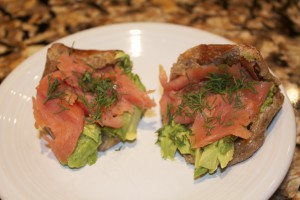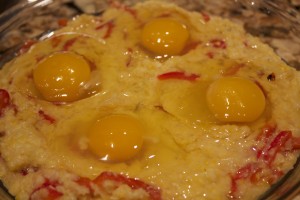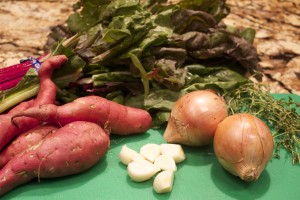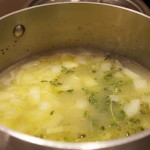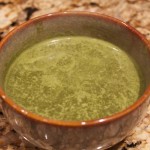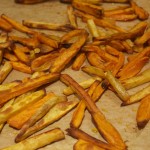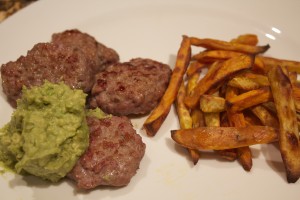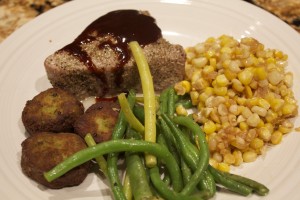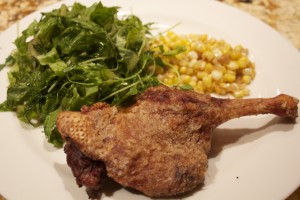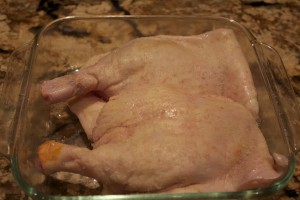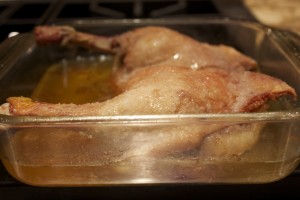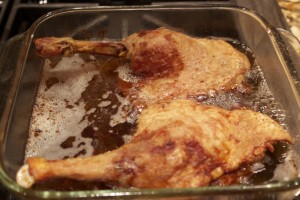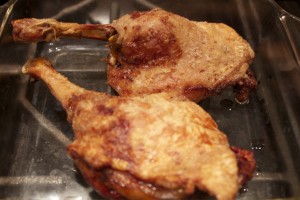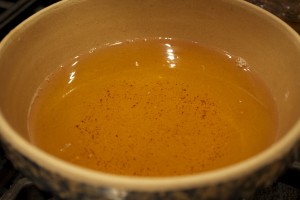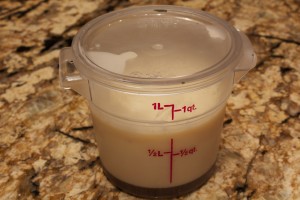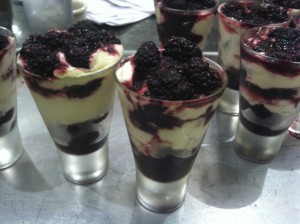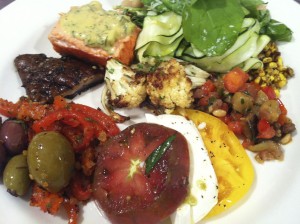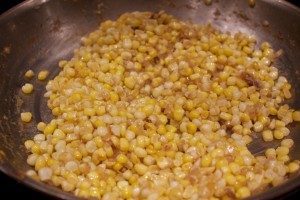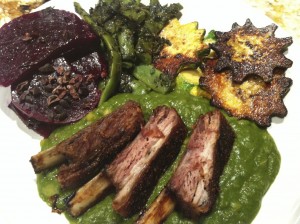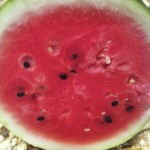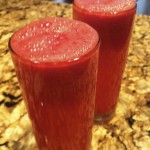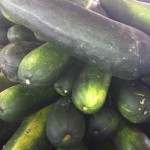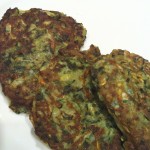
|
Hurricane Sunday Comfort Food Hurricane Sunday was nursery night all day. We stayed in cozy clothes and ate breakfast for every meal. A couple of noteworthy highlights: Mochi with avocado, smoked salmon, and fresh dill. Mochi recently came back on my radar. The sticky pounded rice squares are available in the refrigerator section of natural food stores. Cut off a square no bigger than 2×2 and bake it at 450˚F for 10 minutes, until it puffs. A toaster oven works just fine. Slice open a pocket and fill it with whatever you like, then make sure to eat it while it’s hot and gooey. Another favorite combination is mochi (raisin-cinnamon) with almond butter and sliced bananas with a drizzle honey. Supper continued in the breakfast mode: Baked eggs with Fresh Corn Polenta I pureed the kernels from a couple of ears corn, sautéed them in a little butter, then added about ¼ cup of corn grits, ¼ teaspoon salt, and a cup water. I cooked it in a medium skillet, stirring frequently, for about 5 minutes, then stirred in a sliced roasted red pepper. I transferred the whole corn mass to a pie plate, made a few craters, and cracked an egg into each indent. I sprinkled a lttle salt over the eggs along with a few drops water, and baked them in a 350 degree oven for about 25 minutes. Seriously delicious. Share on Facebook and Twitter | Breakfast, Corn, Dinner, Eggs, ingredients, Main course, Recipes | No comments
Night Before Irene We were among the lucky to have been in Manhattan during hurricane Irene. Still, we didn’t know how hard the storm would hit, but we did know the city would shut down public transportation as of noon on Saturday. It seemed wisest to stock up with eatables. Everyone seemed of the same mindset; the markets on Friday afternoon were teeming, and rumors circulated at Union Square that the greenmarket would be closed on Saturday. Half of the farmers did show up, however, and they did brisk business. Hats off to those intrepid farmers. It was a good weekend to attend to some home projects without the guilt of feeling I should be out and about. I wanted our food to be quick and comforting – and, of course, delicious and nutritious. The menu: Purée of Swiss Chard soup, roasted sweet potato fingers, and turkey sausage with avocado mustard. Purée of sweet potato soup: I sweated a couple cups onions in olive oil, then added half a dozen peeled whole garlic cloves, a dime’s thickness of fresh thyme springs, a couple of peeled fingerling potatoes, teaspoon salt and a quart of chicken stock that I had from one of my favorite greenmarket purveyors (Garden of Spice, which are at the Union Square on Wednesdays). I let the soup simmer partially covered beautiful chard (stemmed) and let it wilt in the hot soup for a couple of minutes. I blended the soup, put it back in the pot, added a squeeze of lemon, a sprinkling black pepper, and adjusted the salt. Meanwhile, I roasted these sweet potatoes (mix of white and orange) in virgin coconut oil and salt. Coconut oil gives the sweet potatoes a delicious buttery flavor. I smashed an avocado with a dollop of Dijon mustard and cooked up sweet turkey sausage from Di Paulo farms. The sausage is beautifully spiced and ready to cook. Everyone loves it! http://brooklynbased.net/email/2010/11/where-to-get-your-gobble-gobble/. (This link has a description of the poultry farmers at Union Square. Not all have websites. The link also includes some purveyors that ship pasture-raised poultry.) It was a casual and satisfying meal on the eve of an impending storm. Share on Facebook and Twitter | Dinner, Greenmarket Bits, Recipes, Where To Buy (Sources) | No comments
Olive Oil Poached Tuna I had corn left over from the duck confit meal, and I had edamame cakes that I had previously frozen, so I decided to work my dinner around those. Since I was near Chelsea Market, I stopped in The Lobster Place (lobsterplace.com/), one of the best fish markets in New York City. I picked up a couple of gorgeous chunks of tuna to poach in olive oil that I had already in my refrigerator. You can oil poach with tuna, salmon, halibut, and shrimp, and use the oil as much as four times. Don’t worry – the oil doesn’t smell, because you are heating it to 120˚F, which is really low. The oven is heated to 225˚. You need a thermometer – a probe is the best variety. I have a Poulder, but any type is good. You need to have enough oil in the pan to be able to immerse your fish in oil and your skillet should have straight sides. I rubbed the steaks with a combination of salt, pepper, and ground fennel. My refrigerated oil looked solid (extra virgin olive oil is a monounsaturated fat, which goes semi-solid when cold) but it quickly melted over low heat. As soon as the oil had melted, I added the thermometer. I hold back on some of the oil, because it is easy to overshoot the 120˚F. When that happens, I can add a glob of cold oil and lower the temperature quickly. Otherwise, I simply wait for the oil to cool until the proper temperature. Add the fish (make sure it’s completely immersed) and place the skillet in the oven for 25 minutes. When ready, remove the fish and strain the oil. I served the fish with the following recipe for Teriyaki Ketchup from my book The Healthy Hedonist. In the book it’s paired with a tuna burger. 2 tablespoons shoyu (natural soy sauce) 1/4 cup sake or mirin (substitute with dry sherry) 2 tablespoons maple syrup 2 teaspoons tomato paste 1 teaspoons dijon mustard
Share on Facebook and Twitter | Dinner, Fats & Oils, Recipes, Sauces | No comments
Duck Confit Duck confit is arguably the tastiest way to eat duck. The legs are slowly cooked in a low oven until all of the fat is rendered, leaving a skin that is super crispy – tastes fried – and flesh that pulls off the bone. It’s a dish that lots of folk are fearful of making at home (the thought of cooking in all that fat can be scary) Confit tastes rich, so a little goes a long way. If you get your duck from a purveyor that raises the ducks traditionally, the dish is healthy as well. I paired the Sautéed Corn with Balsamic and Shallots (last post) with the duck confit and a romaine salad that had pea shoots, dill, and a lemon olive-oil dressing. The whole meal took only half an hour of active time. Start with the plumpest duck legs you can find. At Union Square Greenmarket, Hudsen Valley Duck farm are out on Mondays, so that’s the day I usually buy the legs. I get the Moulard, which is a cross between a Pekin and Muscovy. These are large birds with rich flavor. The duck legs make terrific confit – no need to add any extra fat. http://www.hudsonvalleyduckfarm.com/blog/ for more info about Hudson Valley duck farm. Remove the ducks from the refrigerator about an hour before you want to get them in the oven. They take about two hours in the oven, so plan accordingly. Prick the skin all over with the tip of a sharp knife, making sure just to prick into the fat, not the flesh. This will help the fat render while the legs cook. Sprinkle an even dusting of salt all over the ducks, both skin side and underneath. Place the legs in a baking pan that holds them snugly, and let sit at room temperature for 1 hour.
After about 1 ½ hours, the skin will start to color. Turn up the heat to 375˚F. and cook for an additional half hour until the skin is evenly golden and crispy looking. Remove the pan from the oven, lift the legs from the pan with a tongs, and strain the fat. You’ll have quite a bit. Save the fat to use later. Later on, when the fat cools down, add it to a container and refrigerate. Here’s my container of duck fat that I use it when I want to make confit, and I only have small duck legs. I add a layer of fat to the pan under the legs before I place them in the oven to give them a head start. Enjoy the confit hot, room temperature, or chilled. Share on Facebook and Twitter | Dinner, Main course, Recipes | No comments
Sautéed Corn with Shallots and Balsamic Vinegar Last Friday evening I taught an antipasto class at the Natural Gourmet. The recipes were designed specifically with August entertaining in mind. Everything is at room temperature and can be made in advance, including these blackberry parfaits. The students did a great job on the whole menu. A lot of the recipes were really simple. Monday I was thinking about the sautéed corn with balsamic vinegar and shallots, one of the dishes from the class. Fresh local corn is stunning right now, so I picked some up at Union Square. Since Hudsen Valley Farms are at the Union Square Greenmarket on Mondays, I decided that a good duck confit with the corn would be a special meal, but would require only minutes of active time. Here’s the recipe for my Sautéed Corn with Balsamic Vinegar and Shallots which is a quick version of Swiss Chard with Corn and Balsamic Vinegar from The Healthy Hedonist.
Serves 4 1/4 tablespoon extra virgin olive oil 1/2 cup minced shallots 4 ears corn, husked and silk removed, kernels removed (about 2 cups) 1/2 teaspoon salt 1 tablespoon + 1 teaspoon balsamic vinegar freshly ground black pepper Warm the olive oil in a large skillet over medium heat. Add the shallots and corn kernels and salt. Sauté over medium heat until the corn has released its liquid and the shallots have started to brown, about 4 minutes. Stir in the balsamic vinegar, scrape up the brown bits and turn off the heat. Sprinkle with freshly ground black pepper. Remove the corn to a serving dish. Serve warm or at room temperature. Share on Facebook and Twitter | Corn, Dinner, ingredients, Recipes, Side Dishes | No comments
The Meal Continues Although the lamb riblet meal blog entry was almost two weeks ago, I’ve done a lot of cooking since then. I’m going to use this “hunker down” period in New York to catch up with some of the more noteworthy meals. It’s eerily quiet outside. Subways and businesses are shut down – pretty much everything is closed in preparation for the hurricane. In the city, though, it has not even started to rain. After my last post, I had about 7 leftover riblets. I would not have cooked so many at once, but I had bought a 3 1/2 pound pack from 3 Corner Field Farm (www.dairysheepfarm.com) at the Greenmarket one Saturday. Since I had to defrost all of the riblets at once, I knew we would have enough for two meals. I wanted the meals to be different from each other. The day after making the riblets I taught a pasta-making class to the professional students at the Natural Gourmet. The class was small that day, and there was a lot of food left over. I made use of the cooked beets and white bean sauce. I tossed the beets with balsamic vinegar and cocoa nibs, and blended the white bean sauce with some Swiss Chard, which I wilted quickly first. The reheated riblets were delicious over the creamy sauce. I picked up some patty pan squash at the greenmarket on the way home, which I sliced, sprinkled with salt, and then left to “sweat” for 20 minutes. I sautéed them until golden on each side, a couple of minutes per side. The flat beans I cooked in a small amount of water (sort of steaming it in the pan) with a sprinkle of salt. When they were cooked, after about 5 minutes, I tossed them with the basil puree I had made the day before. It was a delicious, quick, vegetable-packed meal. Here’s the recipe for the White Bean Sauce, from my first book The Voluptuous Vegan. You can freeze it and have the sauce ready to whip out at a moment’s notice. Serves 6 2 tablespoons extra virgin olive oil 2 cups onions 8 cloves garlic, thinly sliced 3 ½ cups cooked cannellini beans (or navy or great northern) or 2 15-ounce cans Salt 5 sprigs fresh sage Handful fresh thyme sprigs 1 bay leaf 2 teaspoons fresh lemon juice Freshly Milled Black Pepper Warm the olive oil in a medium pot. Add the onions and cook over medium-low heat until the onions are softened and starting to brown, about 7 minutes. Add the garlic and cook a few more minutes. Add the beans and 2 ½ cups water (or better yet, bean cooking liquid if you have it) along with 1 ½ teaspoons salt. Tie the herbs together with a cotton string and add them to the pot along with the bay leaf. Cover, and bring to a boil. Lower the heat and simmer, partially covered, for 15 minutes to allow the flavors to marry. Add the lemon juice and a sprinkling black pepper. Taste and add more salt if necessary. Remove the bay leaf and tied herbs.
August Report from the Union Square Greenmarket Saturday was my first day back at Union Square greenmarket after a period of traveling. I had to restrain myself from buying everything in sight. Here’s some notes and a record of what I made from my purchases: These late New York season strawberries were irresistible – super sweet, the best strawberries of the year. I was thrilled to see piles of watermelons. It’s melon season, of course. A note to purchasing just the right ripe melon: Please make sure to knock on the melon, as if you were knocking on someone’s door. If it’s ripe and sweet, it will sound hollow. I scored with this one.
The extra went into these popsicle molds.
The sight of these elephant-sized zucchini stopped me in my tracks. I was assured that once the seedy middle was cut out, the remaining part would be sweet. While I am intrigued by the thought of stuffing one of these, I refrained from purchasing them . Instead I came home with a large bunch basil, some yellow and green zucchini, a few ears of corn, and a couple of racks of lamb riblets. When I got home, I picked the leaves off of the basil and pureed it with extra virgin olive oil to keep it fresh. I knew I had little time to make dinner today, but nonetheless I wanted a delicious meal. I got home in the late afternoon, and had a lot to do besides make dinner. I decided to construct a meal that would cook slowly (lamb riblets take over 2 hours) but would require minimal active time. I had defrosted the lamb riblets overnight in the refrigerator. I had some barbecue spice rub (from The Healthy Hedonist, which consisted of a mix of salt, maple sugar, cumin, chili powder, black pepper, cayenne, and paprika) in a little container, so rubbing the mix on the riblets and placing them in the oven on a parchment-covered baking sheet took only a matter of minutes. An hour later, I turned down the heat from 325˚to 225˚. An hour after that (by this time it was 6:45) I started the rest of the dinner. I grated the zucchini (one yellow and one green) and mixed it in a bowl with ½ teaspoon salt. I let it sit for fifteen minutes. Meanwhile, I filled a medium pot with water, placed it on the stove, and husked the corn. Fifteen minutes later, I cranked up the heat on the burner under the pot. I squeezed the water out of the zucchini, and placed it back in the bowl, and mixed it with a couple of tablespoons unbleached white flour, a scoop of the basil puree made the day before, and one egg. I dropped the corn in the boiling water and a tablespoon or so of coconut oil to heat in a large non-stick skillet. I dolloped spoonfuls of pancake batter into the skillet (two zucchini yielded 7 medium- sized) and cooked the pancakes for 2 to 3 minutes per side, until golden.
Share on Facebook and Twitter | Dinner, Fruit, Greenmarket Bits, Kitchen Tips, Main course | No comments
|
